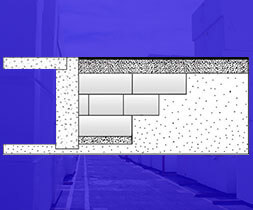
To learn more about the benefits of Geofoam International in Road Construction, call today: 844-773-3626
The expanded polystyrene material that makes up EPS geofoam block allows it to be ultra-lightweight yet strong. One of the major applications that foam block material is used for is to support bridge construction. Geofoam blocks have a high compressive resistance rate which makes it perfect to support oncoming traffic and the repeated stress and compression that takes place on structures like bridges.
Foam insulation blocks can be layered and shaped to create bridge abutments and provides a sturdy foundation that’s both cost-effective and more optimal than other traditional fill materials such as soil, concrete and rocks.

Because it is lightweight and easy to shape, bridge engineers and architects gravitate towards using it to construct bridge foundations.
EPS Geofoam can be used to support bridges when designed to the proper specification. The material adds little additional load to the underlying ground and therefore is a perfect material for the construction of a bridge structure. The soil underneath these bridge abutments is barely impacted because the lower weight of geofoam imposes the least amount of stress on it. As a result, the surrounding environment becomes more sustainable and acts as a stronger, longer-lasting foundation for a bridge.
In cases of a bridge being rehabilitated because it is no longer structurally stable enough to hold the loads of current traffic, EPS Geofoam infill can help support the span and transfer the traffic load safely to the building foundation or underlying soil.
Geofoam is being used more and more as the main material to build bridge abutments thanks to the multiple benefits it brings versus concrete and other traditional filling methods. For one, it is extremely cost-effective because of the flexibility it offers. Labor costs and timelines for construction projects are cut down due to the benefits of its lightweight and customizable features. Foam construction blocks also minimizes maintenance because of the material has a durable compression factor. Another positive of using geofoam to form bridge abutments is that it does not breakdown. This is particularly relevant within the context of bridge construction because bridges are often placed in environments that have natural elements surrounding them, and these external factors like soil and moisture can work to impose wear and tear on supporting structures that make up the bridge. EPS geofoam is resistant to potential damaging factors.
When it comes to finding the right void fill to construct bridge abutments, the easy choice is geofoam blocks. You can construct highly supportive structures quickly and easily with EPS high-density foam blocks in nearly any sort of weather conditions and environments.

Distributor of Expanded Polystyrene block for use in construction applications throughout the world
